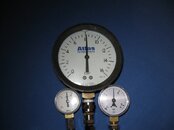driftwood
Contributor
There is a current thread on how often a reg should be inspected,
Regulator annual inspection.
LeisurePro is selling IPG's for $18.70, Intermediate Pressure Gauge Plugs Into The BCD Quick Disconnect Hose | LeisurePro
Easy to learn what the gauge is telling you.
Regulator annual inspection.
LeisurePro is selling IPG's for $18.70, Intermediate Pressure Gauge Plugs Into The BCD Quick Disconnect Hose | LeisurePro
Easy to learn what the gauge is telling you.





